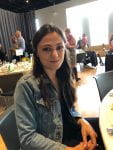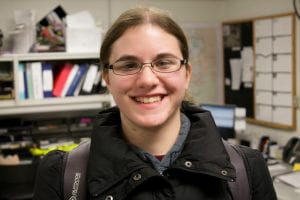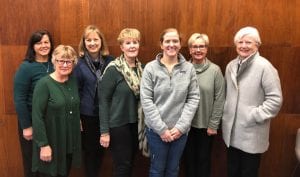Category: Grad Student Spotlight
Curtis Colwell and Jasti Lab Research covered in ChemistryWorld Magazine
4 PhD Students and 3 Undergrads win NSF GRFP in Chemistry
Four PhD students and three undergraduates in the UO department of Chemistry and Biochemistry have been selected by the National Science Foundation for the Graduate Research Fellowship Program (GRFP):
The [GRFP] program recognizes and supports outstanding graduate students in NSF-supported science, technology, engineering, and mathematics disciplines who are pursuing research-based master’s and doctoral degrees at accredited United States institutions. Fellows benefit from a three-year annual stipend of $34,000 along with a $12,000 cost of education allowance for tuition and fees (paid to the institution), opportunities for international research and professional development, and the freedom to conduct their own research at any accredited U.S. institution of graduate education they choose. As the oldest graduate fellowship of its kind, the GRFP has a long history of selecting recipients who achieve high levels of success in their future academic and professional careers.
Our 2020 recipients:
PhD
Alison Chang
Marc Foster
Khoa Le
James May
Undergraduates
Madi Scott
Makenna Pennel
Casey Bisted – 2019 grad, now in PhD program at UW
Our Honorable Mentions:
PhD
Julia Fehr
Grace Kuhl
Gabrielle Warren
Undergraduate
Dylan Bardgett
This is our department’s highest number of GRFP fellowship recipients and honorable mentions to date. Special thanks to faculty members Shannon Boetcher, Mike Pluth, Amanda Cook, Julia Widom, and Chris Hendon for the great job they’ve done teaching the CH 401/601 Fellowship Application Skills workshop.
Hutchison Lab Grad Helps Students Reimagine the Car Seat
Lundquist faculty members and MBA students partnered with the Knight Campus and others to reimagine the car seat.
The result: WAYB’s Pico car seat.
 Among the partners was Aurora Ginzburg, a graduate student in the Hutchison lab, who served as the liaison between WAYB and the students as they sought to integrate greener, more sustainable materials into their new design.
Among the partners was Aurora Ginzburg, a graduate student in the Hutchison lab, who served as the liaison between WAYB and the students as they sought to integrate greener, more sustainable materials into their new design.
Read more in the article below from the Fall 2019 edition of UO Business magazine.
 Loading...
Loading...
Eric Beyerle named John Keana Fellow for 2019-20

Eric Beyerle, a graduate student in Guenza Lab, has been selected as the next John Keana Graduate Student Fellow.
The fellowship was established in 2017 in honor of Professor Emeritus John Keana, and provides annual fellowship awards to graduate students studying in the Department of Chemistry and Biochemistry at the University of Oregon. The award may be used to assist with defraying the academic costs associated with attending the university such as tuition, fees, books, miscellaneous supplies, research and living expenses.
The first John Keana Graduate Student Fellowship was awarded in 2018-19 to Matthew Cerda in the Pluth Lab.
Tawney Knecht Receives DOE Graduate Student Research Award
 Tawney Knecht, a 4th-year chemistry graduate student in the Hutchison Lab, has been selected to receive the U.S. Department of Energy (DOE) Office of Science Graduate Student Research (SCGSR) award. Her proposed research project, “Precisely Nanostructured Indium Oxide Electrocatalysts Toward Efficient CO2 Conversion”, will be conducted at the National Renewable Energy Laboratory (NREL) in Golden, Colorado.
Tawney Knecht, a 4th-year chemistry graduate student in the Hutchison Lab, has been selected to receive the U.S. Department of Energy (DOE) Office of Science Graduate Student Research (SCGSR) award. Her proposed research project, “Precisely Nanostructured Indium Oxide Electrocatalysts Toward Efficient CO2 Conversion”, will be conducted at the National Renewable Energy Laboratory (NREL) in Golden, Colorado.
The SCGSR program provides funding to outstanding U.S. graduate students to pursue part of their graduate thesis research at a DOE laboratory. Tawney is one of 49 new SCGSR awardees from 39 universities across the nation. This research opportunity is expected to advance the graduate students’ overall doctoral thesis and address scientific challenges central to the Office of Science mission by providing access to the expertise, resources, and capabilities available at DOE facilities.
Aurora Ginzburg Receives Sustainability Award
Chemistry graduate student Aurora Ginzburg has been selected for a 2019 Student Leadership in Sustainability Award. The awards program recognizes individuals whose contributions deepen the University of Oregon’s culture of sustainability across a range of institutional activities.
Aurora is a doctoral student in the Hutchison lab.
ARCS Sponsors Celebrate their Scholars’ Successes

On November 14th, members of the Oregon Chapter of the Achievement Rewards for College Students (ARCS) Foundation visited the UO campus to show their support and celebrate as ARCS Scholar Susan Cooper defended her thesis. They also enjoyed a lunch with current ARCS Scholars Amber Rolland and Hannah Bates.
The Oregon Chapter is one of fifteen ARCS Foundation Chapters nationwide. Its membership is made up of Oregon women philanthropists committed to advancing science in America. The chapter seeks to support and nurture young American women and men in doctoral programs as they prepare to take on current and future scientific and medical challenges.The Oregon Chapter has supported over 248 PhD candidates with financial support of over $4.1 million since the chapter was incorporated in 2004.

Current ARCS Scholars in the UO Department of Chemistry and Biochemistry are:
Susan Cooper, Hutchison Lab
Amber Rolland, Prell Lab
Michael Crawford, Wong Lab
Rebecca Keller, Kellman Lab
Hannah Bates, currently rotating in the Haley Lab
Chemistry and Biochemistry 2018 Newsletter
Check out 2018 highlights and catch up with some of our alumni in the latest issue of the UO Chemistry and Biochemistry newsletter!
 Loading...
Loading...
Teamwork leads UO chemists to a new kind of fluorescent dye
Video:Doctoral student Brittany White talks about the collaborative research project she worked on with postdoctoral researcher Yu Zhao and chemistry professors Ramesh Jasti and Mike Pluth.
Teamwork by chemists in two University of Oregon labs has led to a new class of fluorescent dyes that could expand the real-time view of cell activity in medical diagnostics.
In a paper in ACS Central Science, with White as lead author, the group detailed how they fitted organic molecules called nanohoops with a chemical sidechain of sulfonate to make them water soluble and able to penetrate cell membranes. Nanohoops are made with short, circular slices of carbon atoms. Making them in different sizes, the group discovered, produces distinctive colors that can be illuminated in living cells by a single laser burst.
Read the full article in AroundtheO












